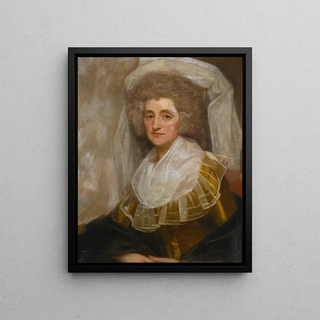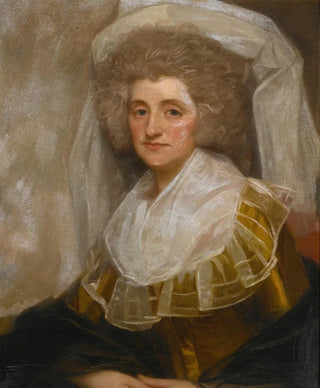Art print | Portrait of Mrs. Francis Ingram - George Romney


View from behind

Frame (optional)
The "Portrait of Mrs. Francis Ingram" by George Romney is an iconic artwork that embodies the elegance and sophistication of the 18th century. This painting, created by one of the masters of English portraiture, offers a fascinating glimpse into the fashion, customs, and aesthetics of its time. Observing this piece, one is immediately transported to a world where beauty and refinement were fundamental values. The depiction of Mrs. Ingram, with her penetrating gaze and graceful posture, reflects an intimacy between the artist and her model, while revealing the subtleties of an era marked by change and innovation.
Style and uniqueness of the artwork
This portrait stands out for its delicate style and nuanced colors, which beautifully capture the personality of the sitter. Romney, known for his ability to grasp the essence of his subjects, employs light and shadow techniques that bring the canvas to life. The drapery of Mrs. Ingram’s dress, carefully rendered, almost feels tangible, while the blurred background highlights the central figure, creating a sense of depth that draws the viewer’s eye. This painting does not merely depict a woman of high society; it also evokes a sense of mystery and grace, inviting the viewer to ponder the inner life of her model. The finesse of the details and mastery of composition make this portrait a work of great singularity, showcasing Romney’s technical virtuosity.
The artist and his influence
George Romney, born in 1734, is a prominent figure in British portraiture. Trained at the painting school, he established himself as one of the most sought-after artists of his time. His style, influenced by masters such as Reynolds and Gainsborough, is characterized by a blend of realism and idealism in his subjects. Romney’s portraits are often imbued with a softness and elegance that transcend mere physical representation. By choosing to paint female figures with such sensitivity, he helped redefine the role of women in art, presenting them not only as objects of beauty but also as complex personalities.

Matte finish

View from behind

Frame (optional)
The "Portrait of Mrs. Francis Ingram" by George Romney is an iconic artwork that embodies the elegance and sophistication of the 18th century. This painting, created by one of the masters of English portraiture, offers a fascinating glimpse into the fashion, customs, and aesthetics of its time. Observing this piece, one is immediately transported to a world where beauty and refinement were fundamental values. The depiction of Mrs. Ingram, with her penetrating gaze and graceful posture, reflects an intimacy between the artist and her model, while revealing the subtleties of an era marked by change and innovation.
Style and uniqueness of the artwork
This portrait stands out for its delicate style and nuanced colors, which beautifully capture the personality of the sitter. Romney, known for his ability to grasp the essence of his subjects, employs light and shadow techniques that bring the canvas to life. The drapery of Mrs. Ingram’s dress, carefully rendered, almost feels tangible, while the blurred background highlights the central figure, creating a sense of depth that draws the viewer’s eye. This painting does not merely depict a woman of high society; it also evokes a sense of mystery and grace, inviting the viewer to ponder the inner life of her model. The finesse of the details and mastery of composition make this portrait a work of great singularity, showcasing Romney’s technical virtuosity.
The artist and his influence
George Romney, born in 1734, is a prominent figure in British portraiture. Trained at the painting school, he established himself as one of the most sought-after artists of his time. His style, influenced by masters such as Reynolds and Gainsborough, is characterized by a blend of realism and idealism in his subjects. Romney’s portraits are often imbued with a softness and elegance that transcend mere physical representation. By choosing to paint female figures with such sensitivity, he helped redefine the role of women in art, presenting them not only as objects of beauty but also as complex personalities.






